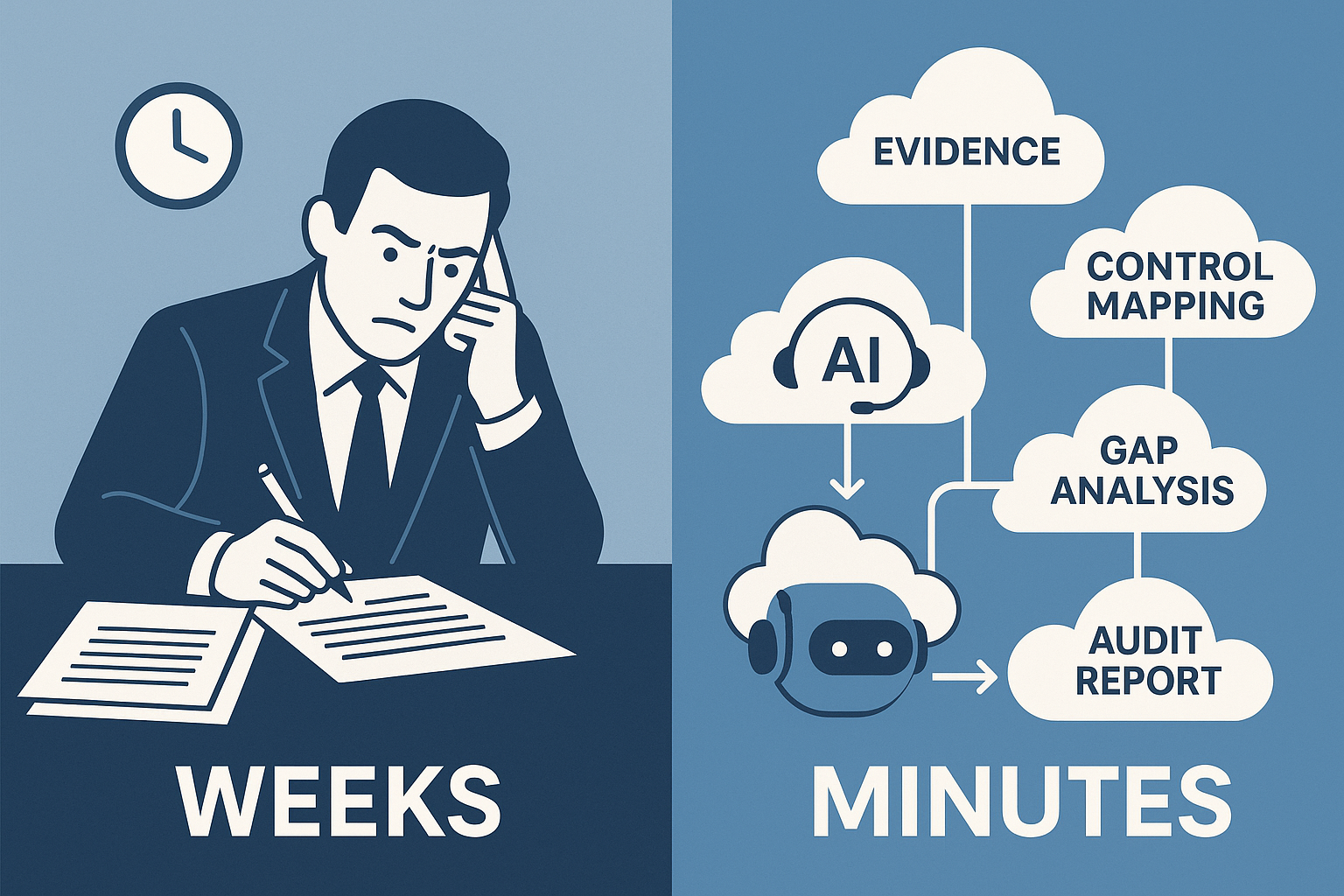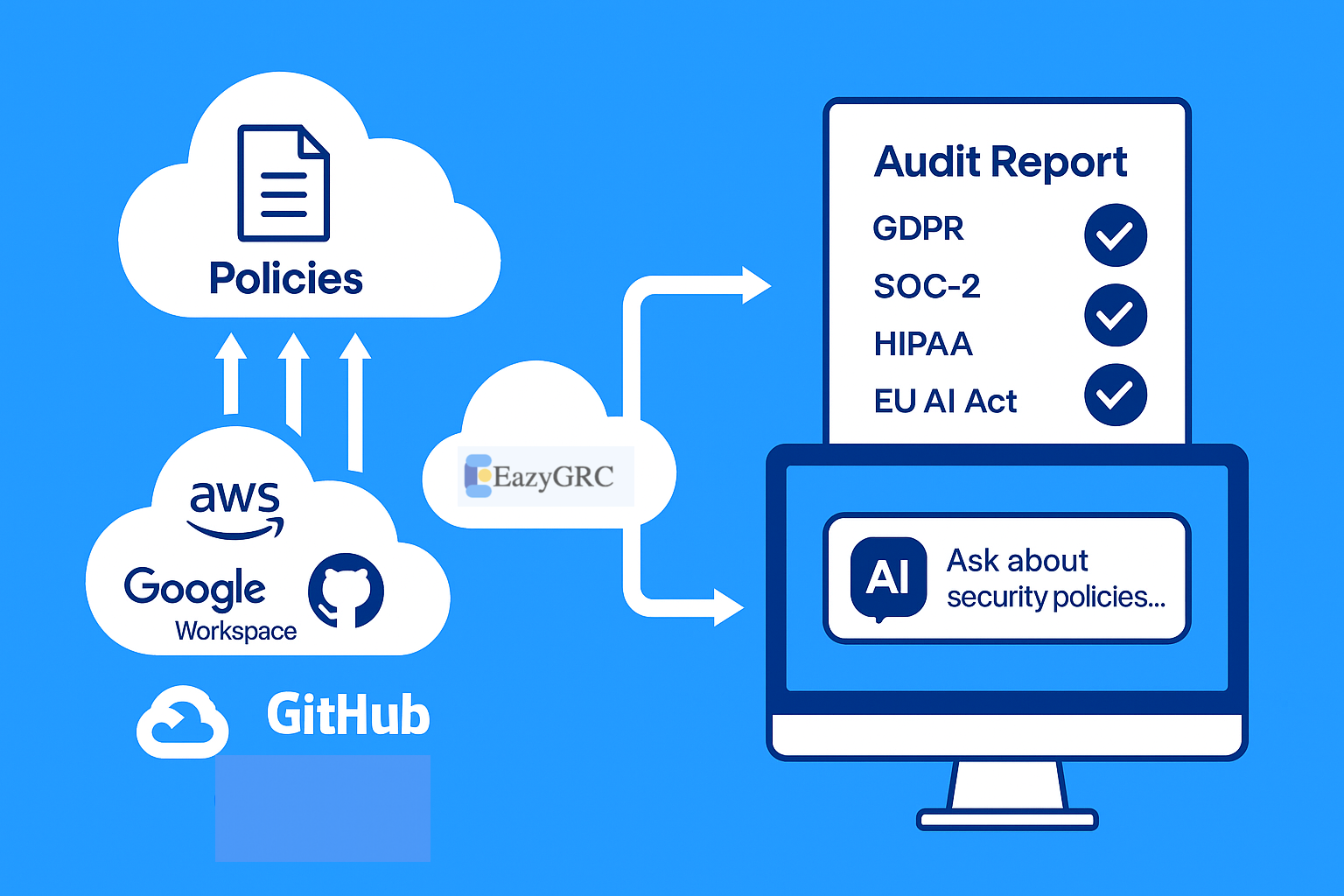AI Agents for GRC: 5-Steps To Audit-Ready Security Program
Using AI agents for GRC to get to an audit-ready state in minutes as opposed to months.

"We love compliance audits," said no one ever. This is especially true for startups and early stage companies who have limited time and resources, and cannot afford to remain buried for months in the audit cycles.
So, a question worth asking is this. What if the process needed to support cybersecurity compliance audits can be accelerated by leveraging AI?
This post describes a 5-step approach to get to an audit-ready state in minutes as opposed to months. It allows teams to quickly and efficiently automate most of the manual and mundane tasks required to complete an audit, and in the process improve the overall maturity of their security GRC program.
Audit Process
A compliance audit for cybersecurity is a combination of two main phases: evidence gathering and evidence analysis.
The first stage involves gathering evidence required to meet compliance requirements. The evidence may comprise of various documents (such as policies), as well as configuration settings from various in-scope systems (such as password settings in Okta, encryption settings in AWS, etc.). The latter kind of evidence can be automated by providing integrations with the target systems, while the former kind can be facilitated by providing templates for required documents.
The second stage involves analyzing the evidence to check how well it meets the corresponding compliance requirements. The analysis requires specialized skills by the auditors (internal and/or external) to carefully evaluate the evidence and identify any gaps. If gaps are revealed, they should be tracked to remediation prior to the start of the audit period. The explanation for any remaining gaps during the actual audit should be documented in the company's audit report.
Audit Readiness
In order to have a successful audit, companies needs to plan and invest in audit readiness. How long it takes and how much it costs is specific to each company and their existing level of security maturity. However, one thing that is common is that the process is almost always a pain, even if its not the first time.
Most companies, especially startups, have limited time and resources to invest in it. Audit readiness may compete with other priorities, such as launching new product features for business growth. This puts strain on the same set of engineering resources who are typically also required to support the audit. At the same time, companies need to produce an audit report to fulfill their compliance obligations and grow their business.
How, then, should companies get ready for audits without the pain?
Using AI Agents
The answer lies in leveraging smart AI agents for GRC.
Both stages of the audit process are suitable candidates to benefit from AI agents. That does not necessarily mean that the end-to-end audit process can or should be automated, as the need for expert opinion will very likely always remain. But it does mean that AI can help bootstrap compliance operations with less cost, time and overhead by automating the manual and repetitive work.
Further, the use of AI agents has additional benefits that last beyond the audit itself. One, companies can benefit from continuous monitoring, which is essentially a continuous gap analysis that reveals any deviation from an audit-ready state. This minimizes the work, and the surprises, that the team has to deal with every year for every audit. Further, the information that the AI agent learns during the readiness process about the GRC program is a vital asset to support business growth, such as to respond to customer inquiries or document requests, and can help turn compliance into a business-enabler.
5-Step Process
Here is a 5-step process of how companies can use AI agents to become audit-ready quickly while improving the overall maturity of their security GRC program.
Step 1. Control Mapping
What does it entail:
- The audit journey typically starts with control mapping; its a process to identify the in-scope controls, which in turn depend on the applicable frameworks (such as SOC-2, HIPAA, GDPR, etc).
- The framework is typically a function of the industry (e.g., HIPAA for healthcare, PCI for payments) or region (e.g., GDPR for Europe) or a standard industry practice (e.g., SOC-2 for SaaS).
- There is a considerable degree of overlap between controls across multiple frameworks. So its possible to leverage the benefits of compliance across multiple frameworks without undergoing a separate audit for each of them.
How AI agents can help:
- An AI agent that has been fine-tuned with knowledge about GRC frameworks can help accelerate the control mapping process.
- The requisite knowledge would include the list of in-scope controls for specific frameworks as well as the evidence that is typically required to satisfy them.
- The output of the agent would be a baseline set of control requirements that the company needs to satisfy to meet its compliance obligations.
Step 2. Evidence Gathering
What does it entail:
- The controls have requirements for specific evidence associated with them which must be supplied to pass that control. Types of evidence range from policies and documents to configuration settings (such as encryption or password) for in-scope systems.
- Evidence from systems, such as configuration settings, are usually supplied for auditor's review in form of screenshots, but can sometimes be automatically retrieved through API calls.
- Policies and documents are typically produced manually, but templates are sometimes available to facilitate the process.
How AI agents can help:
- AI agents can be fine-tuned on the typical context for GRC cybersecurity audits to be able to help with evidence gathering or creation.
- A fine-tuned agent should then be able to retrieve evidence, such as configuration settings, from connected systems via API calls.
- Similarly, such an agent should be able to produce custom templates for policies and documents based on the company's compliance requirements.
Step 3. Gap Analysis
What does it entail:
- Once required evidence has been gathered, the next phase is to analyze it to check how well it meets the corresponding compliance requirements.
- The analysis requires specialized skills by the auditors (internal and/or external) to carefully evaluate the evidence and identify any gaps.
- Compensating controls may be accepted for certain gaps, whereas others may require management response. When a gap cannot be reasonably explained, it may lead to a finding in the audit report.
How AI agents can help:
- AI agents already fine-tuned for both Steps 1 and 2 can be further fine-tuned to learn how to compare the evidence against the requirements to help with the gap analysis process.
- Such an agent can perform the analysis taking into consideration the criteria needed to fully or partially satisfy the controls.
- The output of the agent is a readiness assessment for the auditor's review, produced much faster than a manual process.
Step 4. Remediation
What does it entail:
- If gaps are revealed in Step 3, they should be tracked to remediation prior to the start of the audit period.
- The input for remediation requires specialized skills by the auditors (internal and/or external) consistent with the nature and extent of identified gaps.
- The explanation for any remaining gaps during the actual audit should be documented in the company's audit report.
How AI agents can help:
- AI agents already fine-tuned for Step 3 can be further fine-tuned to suggest remediation for the identified gaps.
- Such an agent can provide remediation guidance taking into consideration the same criterion used to produce the output in Step 3.
- The agent can automatically create tickets for remediation and track them to completion to reduce the risk of un-remediated gaps.
Step 5. Monitoring
What does it entail:
- Once the company has been through the process of audit readiness and all identified gaps are remediated, the focus can shift to continuous monitoring.
- It is essentially a continuous gap analysis that reveals any deviation from an audit-ready state. This minimizes the work, and the surprises, that the team has to deal with every year for every audit.
- Performing a continuous gap analysis manually, however, is a time-consuming effort, and ties up precious resources as well. For this reason, companies are often not able to invest into it between their audit cycles.
How AI agents can help:
- Once an AI agent has been fine-tuned for the above 5 steps, it can be used by the company for continuously monitoring its compliance readiness.
- The agent can frequently and quickly perform the gap analysis on regular intervals and identify any deviations from the audit-ready state.
- The agent can incorporate updates to frameworks or control requirements by additional fine-tuning as needed, at a fraction of manual effort.
Step 6. Bonus!
Just like there is a pot of gold at the end of every rainbow, there is a bonus step that awaits us after we have finished the above 5 steps. As mentioned previously. the information that the AI agents learn during the audit readiness process about the GRC program can be used in turn for other compliance related activities that support business growth.
These include the use of intelligent databases and knowledge bases to quickly and intelligently respond to customer questionnaires, as well as smart trust portals to share elements of the GRC program (such as policy summaries and audit reports) with them. This can help expedite the sales cycle, and turn compliance into a revenue-booster for the company.
Conclusion
This post describes an approach for companies to accelerate their audit readiness, allowing them to get to an audit-ready state in minutes as opposed to months. In the process, it helps them improve the overall maturity of their security GRC program, and turn compliance into a business enabler.
Sign up to receive a copy of our Technical Whitepaper.
Connect with us
If you would like to reach out for guidance or provide other input, or for access to EazyGRC, an agentic AI platform for compliance automation, please do not hesitate to contact us.

